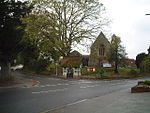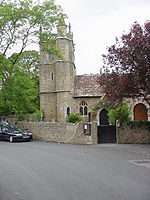Church of St John the Baptist, Churchill

The Church of St John the Baptist in Churchill, Somerset, England, was largely built around 1360 and is a Grade I listed building.There was a Norman chapel on this site in 1180, from which the nave has survived into the present church.The stone font dates from around 1200, although the wooden font cover was added in 1879 when there was a revival in gothic designs. The stained glass windows are from a variety of periods.The tower has three stages with diagonal buttresses, moulded string courses, north-east polygonal higher corner stair turret with blind panelled embattled cap and pierced quatrefoil lozenge parapet with corner pinnacles and gargoyles. It is dated to c. 1360 by Poyntz Wright and after 1420 by Harvey.
Excerpt from the Wikipedia article Church of St John the Baptist, Churchill (License: CC BY-SA 3.0, Authors, Images).Church of St John the Baptist, Churchill
Church Lane,
Geographical coordinates (GPS) Address Nearby Places Show on map
Geographical coordinates (GPS)
| Latitude | Longitude |
|---|---|
| N 51.338542 ° | E -2.808888 ° |
Address
Church Lane
BS25 5LZ
England, United Kingdom
Open on Google Maps









